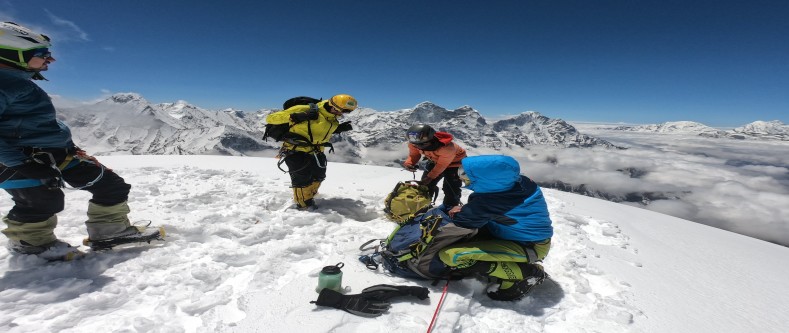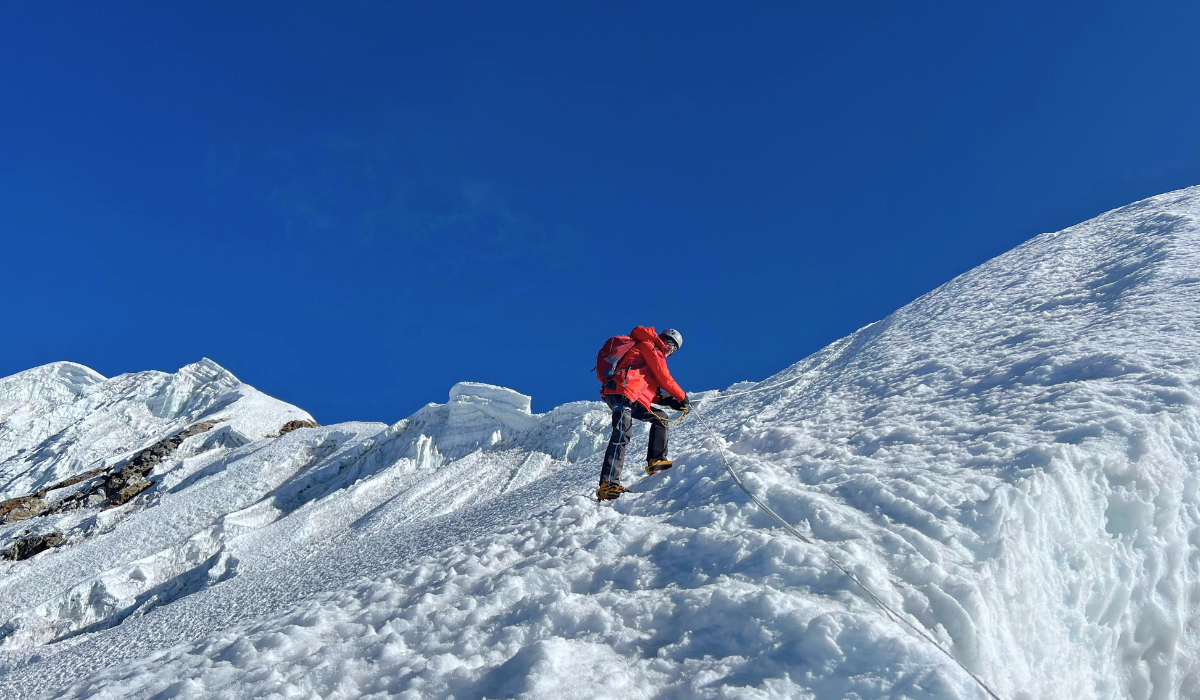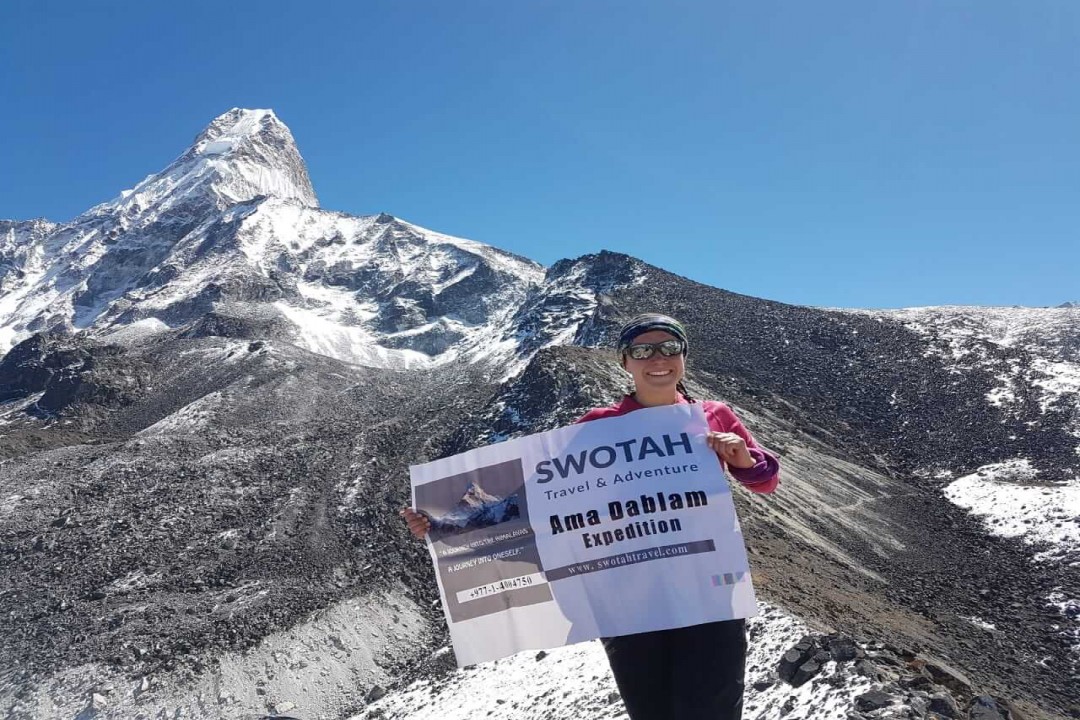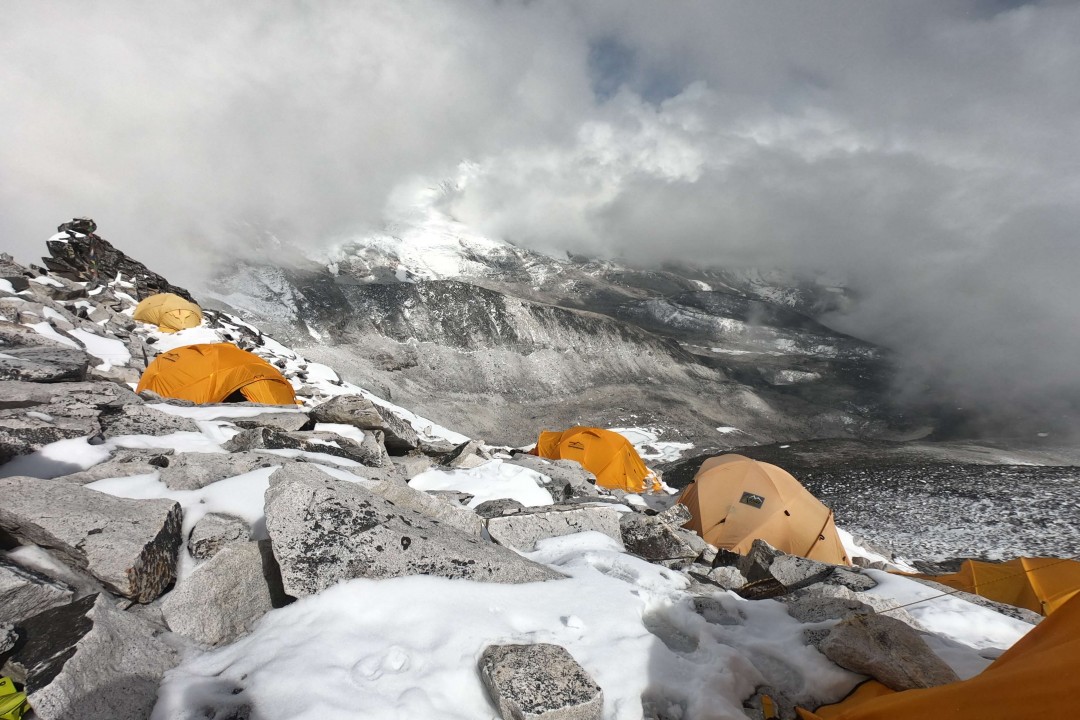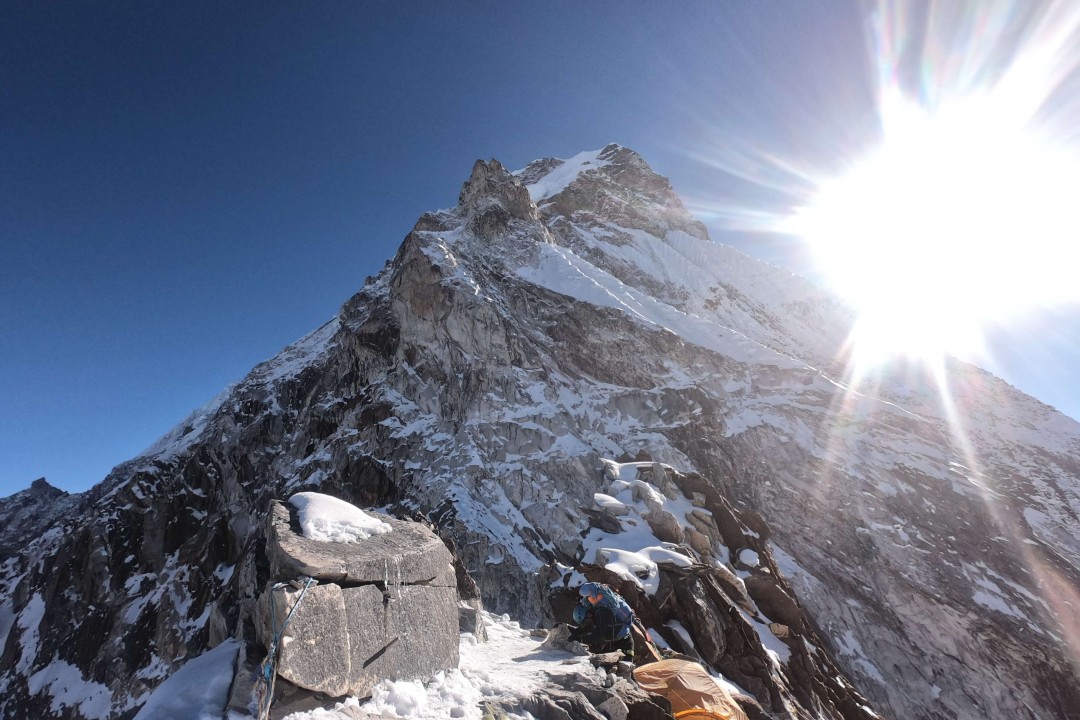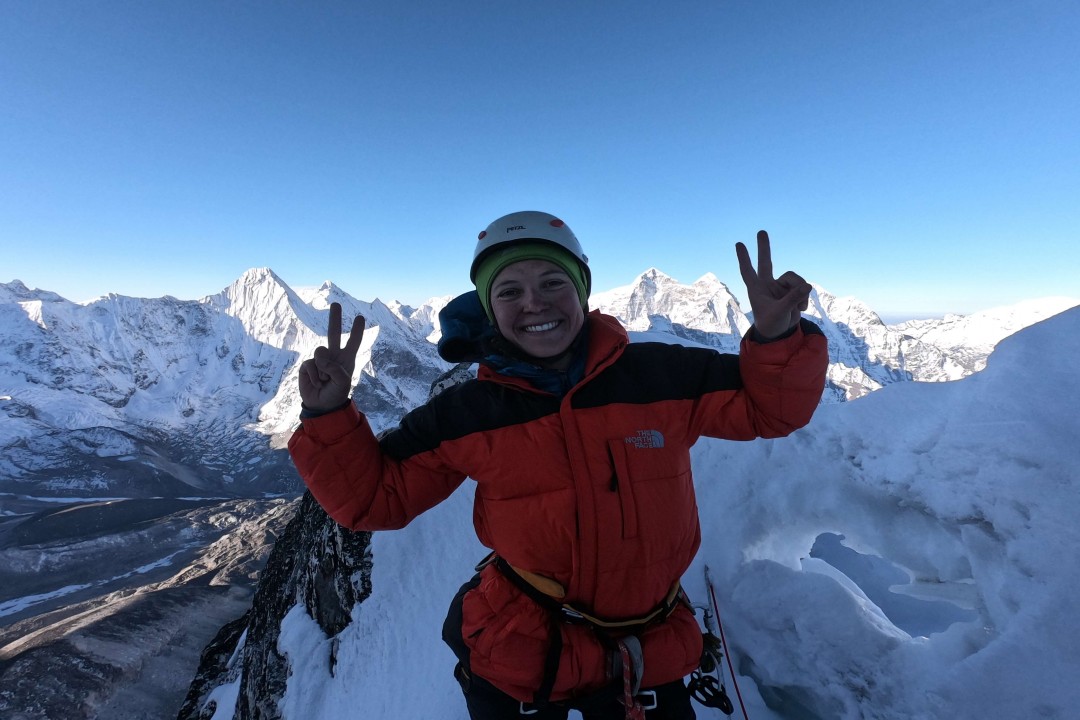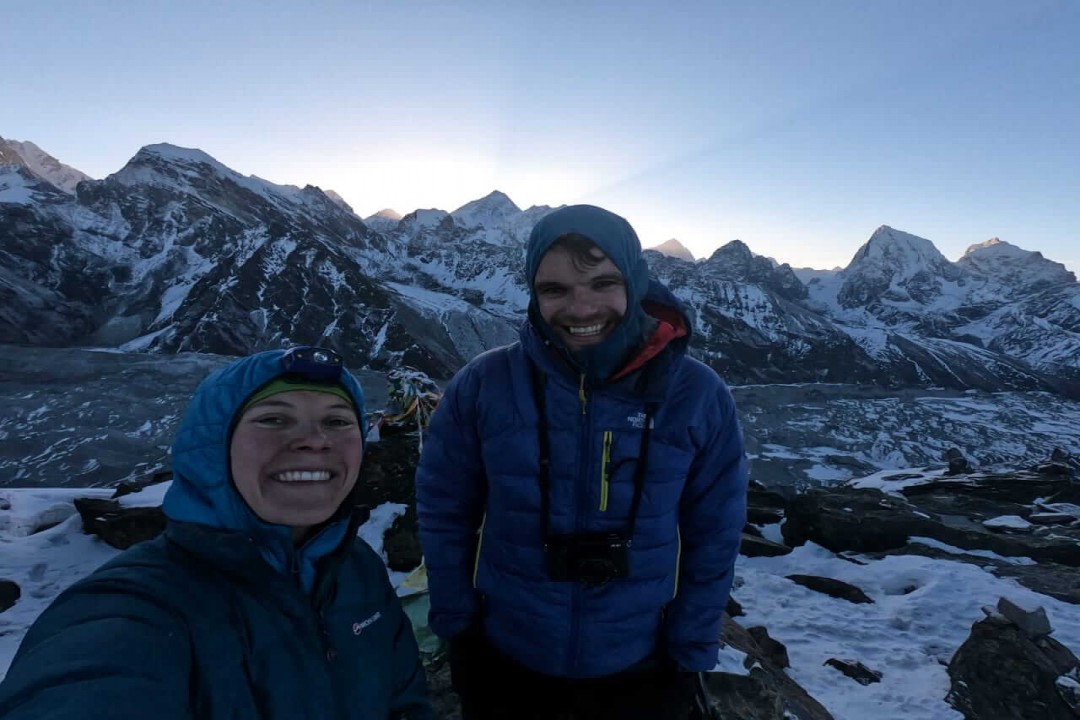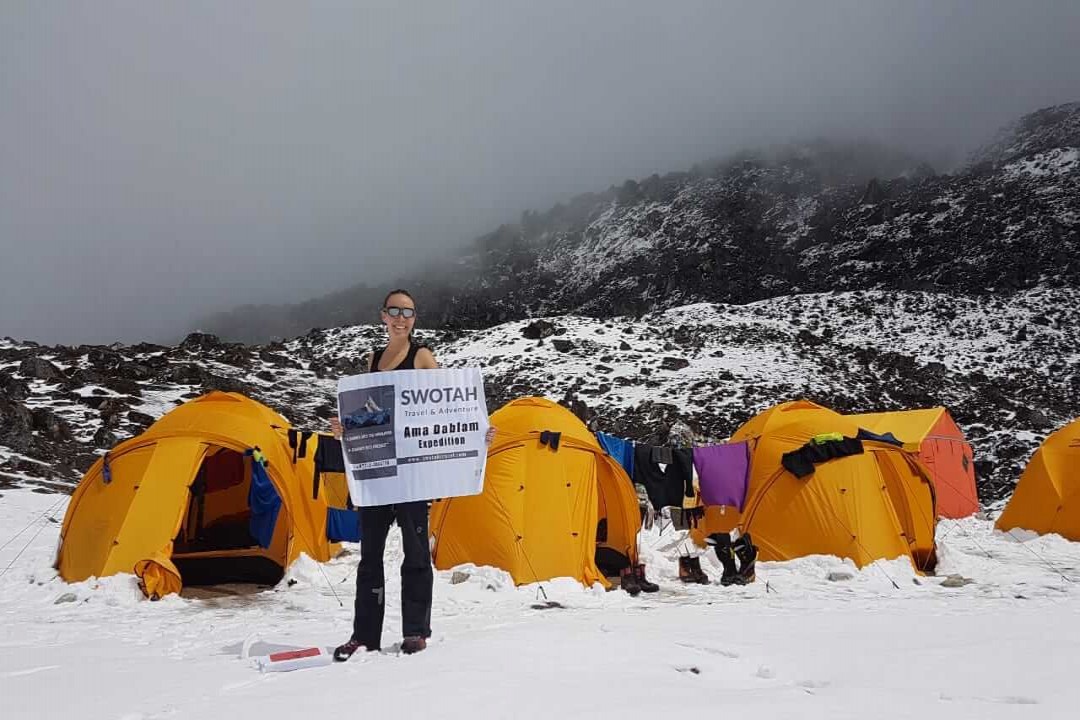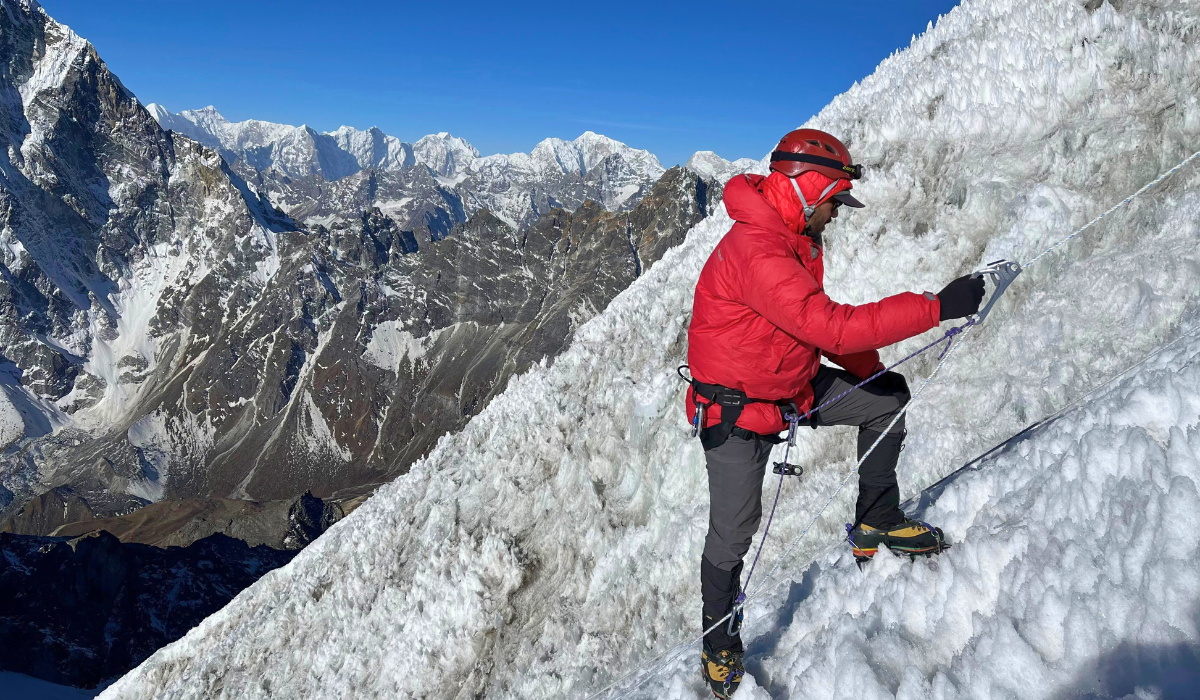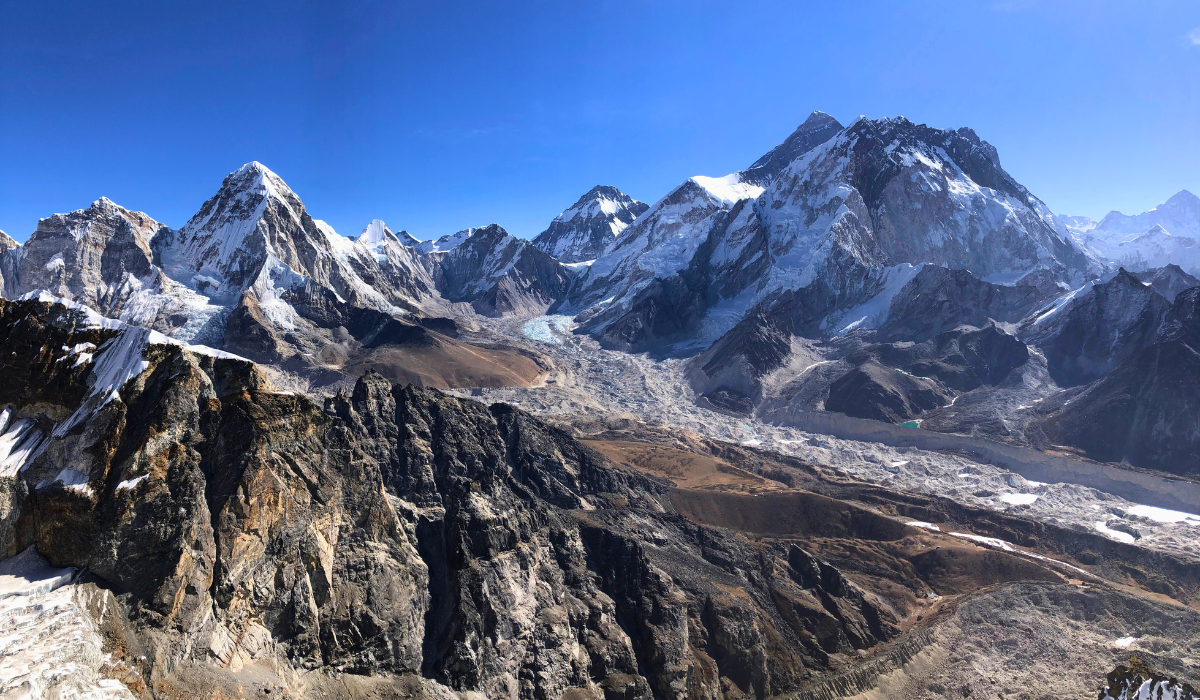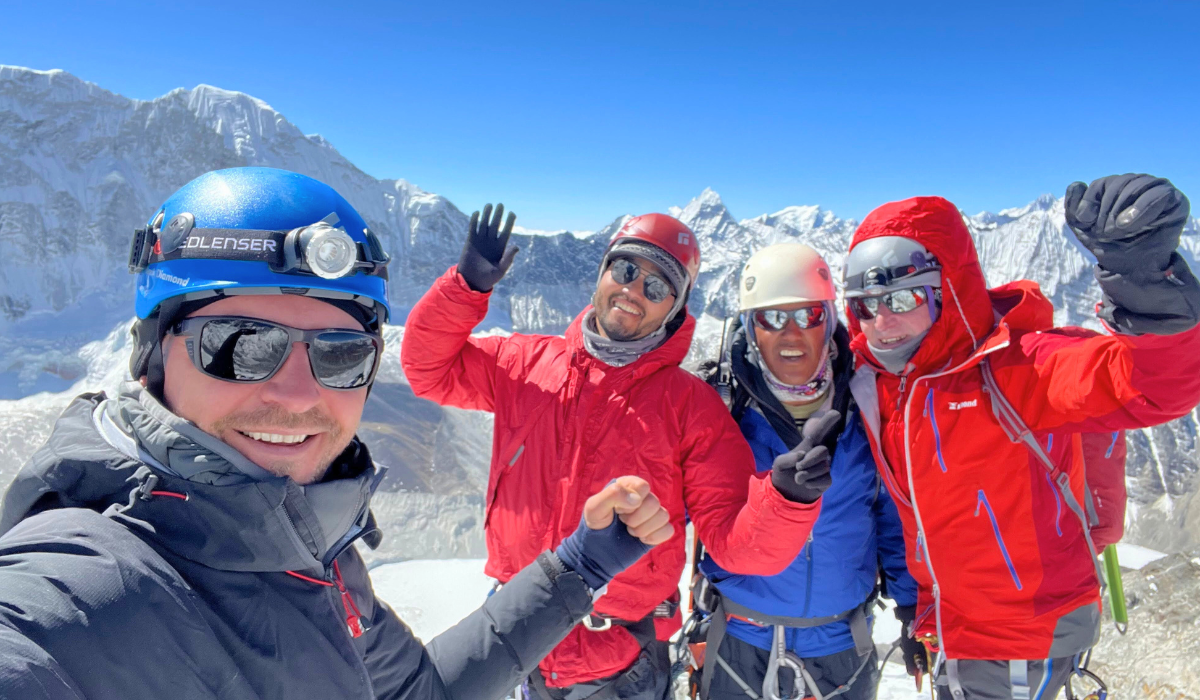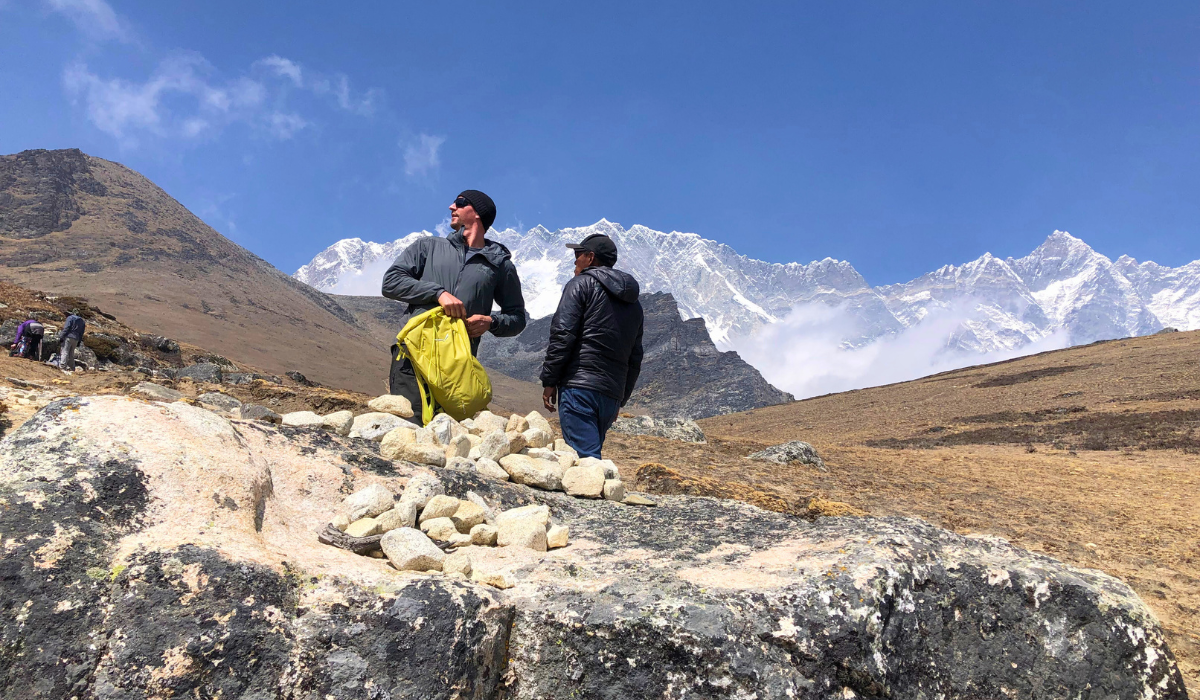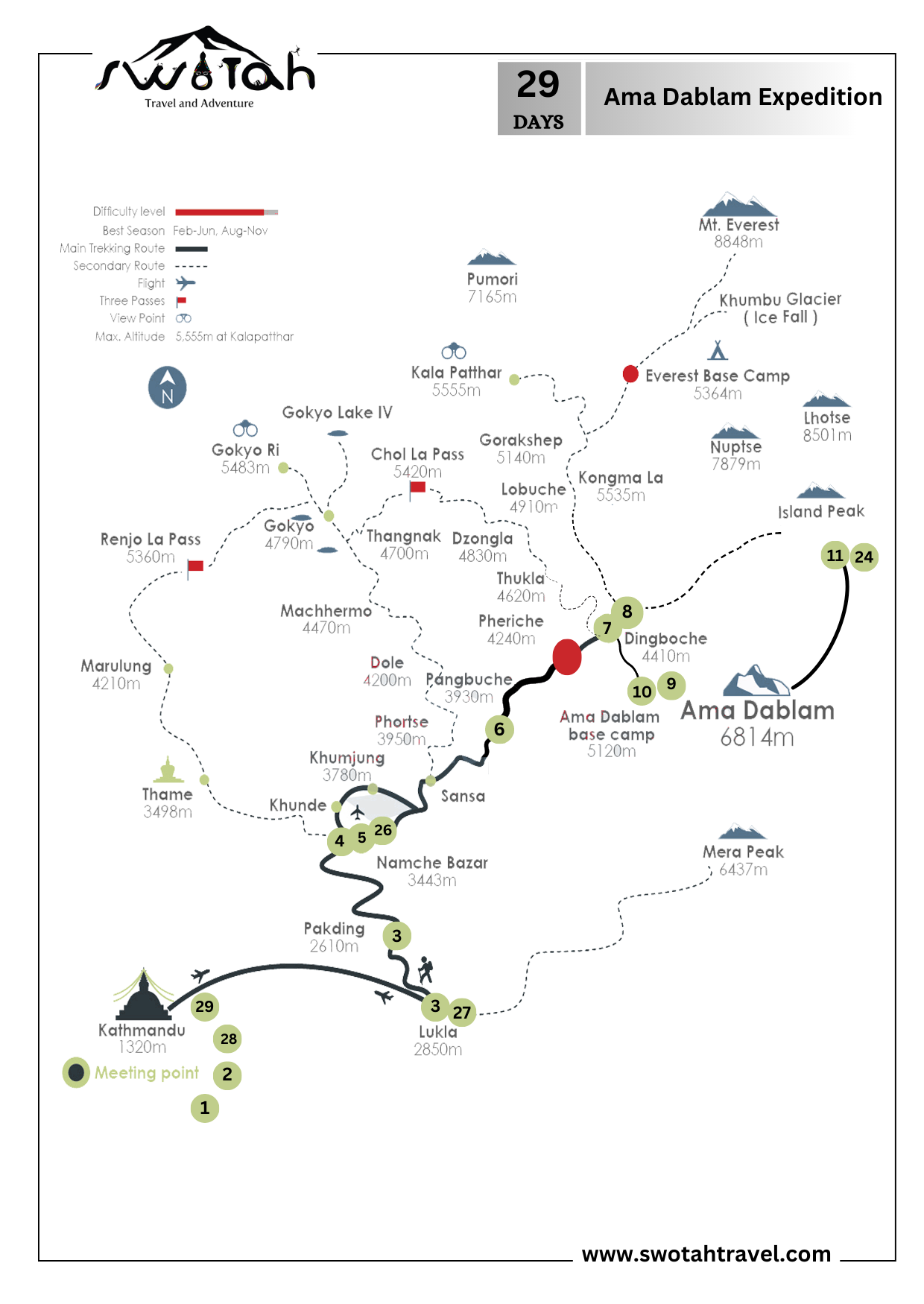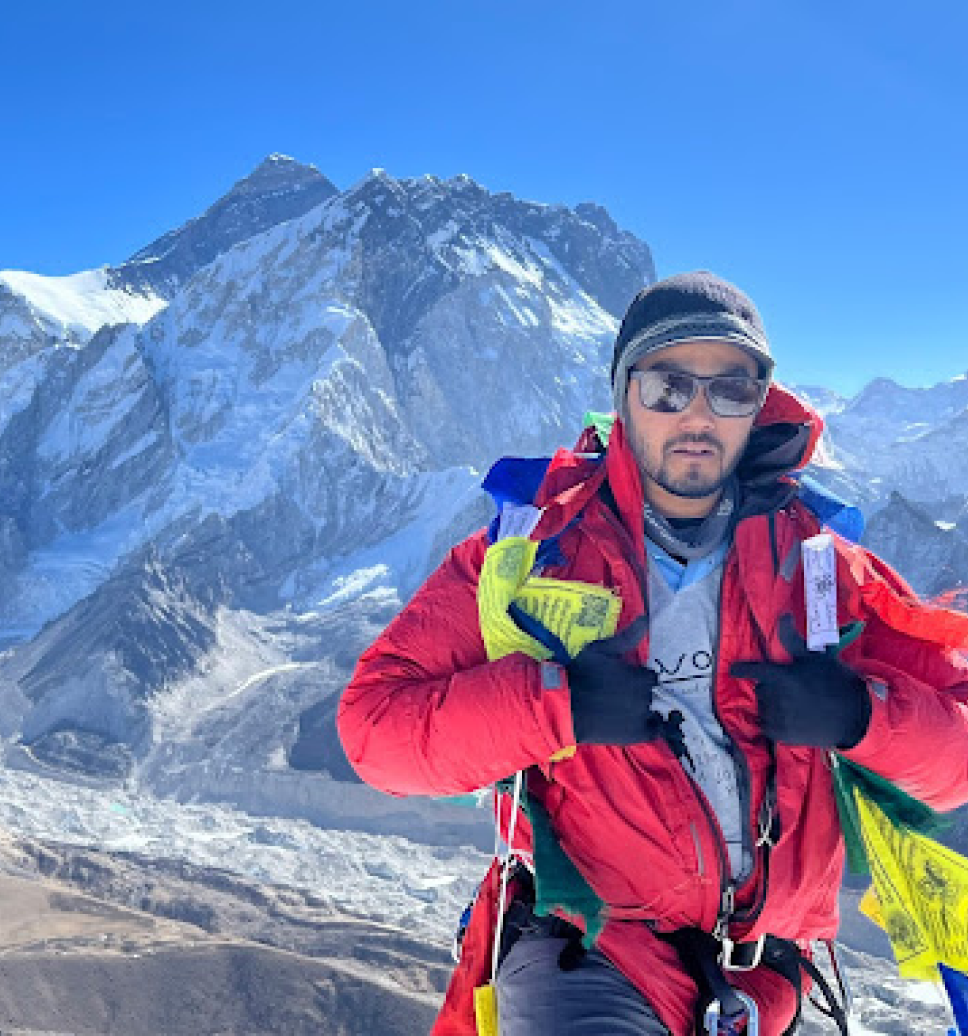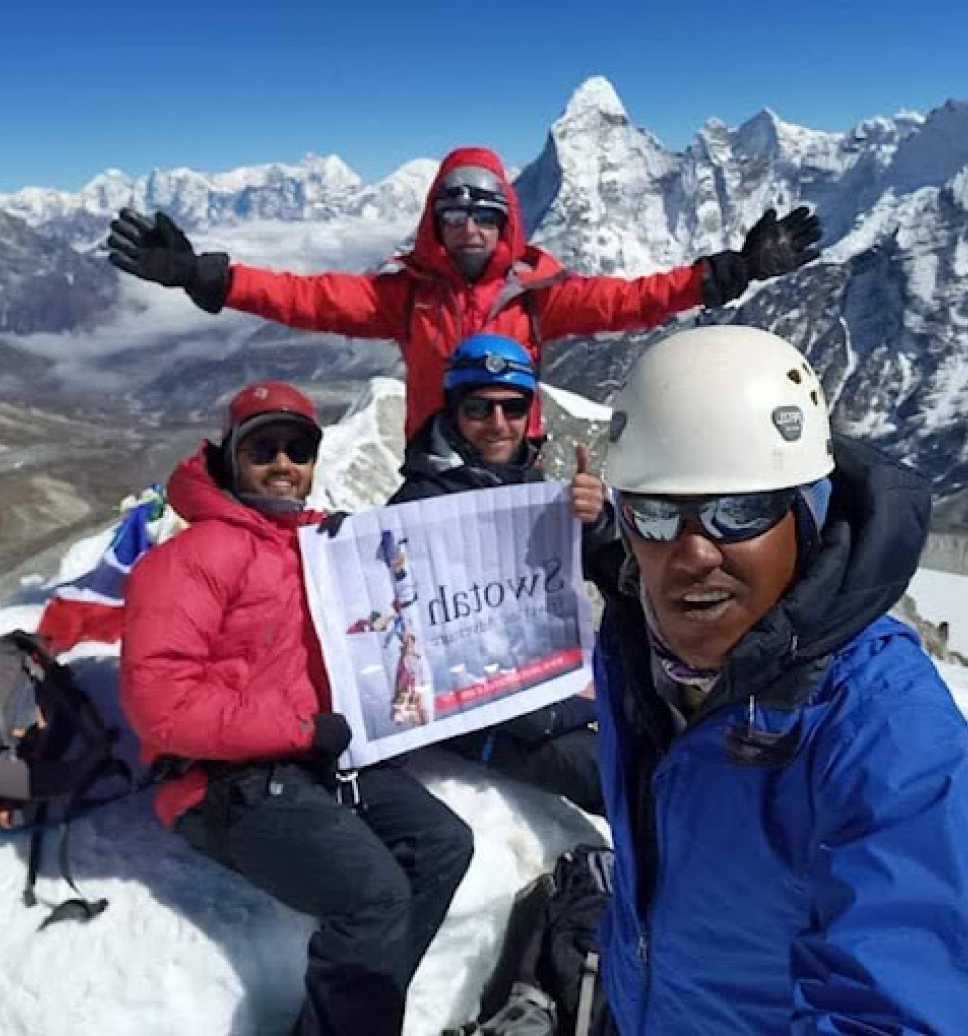GUARANTEED DEPARTURES
Check upcoming trip dates, availability & prices. If you can't see dates that suite you, contact us we will do our best to assist you.
| GUARANTEED DEPARTURES | PRICE | AVAILABILITY | |
| Mar 1, 2026 - Mar 29, 2026 | $7150 | High | |
| Mar 27, 2026 - Apr 23, 2026 | $6999 | High | |
| Apr 2, 2026 - Apr 30, 2026 | $7150 | High | |
| Apr 21, 2026 - May 18, 2026 | $6999 | High | |
| Sep 5, 2026 - Oct 3, 2026 | $7150 | High |
Trek Highlights
- Ama Dablam was first climbed on 13 March 1961 by Mike Gill, Barry Bishop, Mike Ward, and Wally Romanes via the Southwest Ridge.
- The expedition offers panoramic views of Mount Everest, Mount Lhotse, Mount Makalu, Mount Cho Oyu, and many other Himalayan peaks.
- Ama Dablam’s main peak stands at 6,812 meters (22,349 feet), with a lower western peak at 6,170 meters (20,243 feet).
- Known as the "Matterhorn of the Himalayas," it is one of the most striking and iconic peaks in the Khumbu region.
- Ranked as the third most popular Himalayan peak for permitted expeditions, after Everest and Island Peak.
- Despite its lower elevation compared to 8,000-meter giants, Ama Dablam is considered one of the technically challenging climbs in Nepal.
- The classic Southwest Ridge Route combines rock, snow, and ice climbing with thrilling exposure and technical sections.
- Provides a unique chance to trek through the culturally rich Khumbu Valley, passing Sherpa villages, monasteries, and lush landscapes.
- Experience one of the world’s most rewarding and visually stunning climbs with breathtaking views and an unforgettable adventure.

Ama Dablam is a perfect choice for climbers seeking a thrilling technical challenge without the time commitment of an 8,000-meter peak. It’s more demanding than most Everest routes, offering an incredible sense of accomplishment with breathtaking views and a shorter expedition timeframe.
Photo Gallery
Dive into our gallery to get a glimpse of the awe-inspiring vistas waiting for you on our guided treks across stunning landscapes.
Brief Itinerary
Day
1
Arrival in Kathmandu (1,400m / 4,593 ft)
Day
2
Kathmandu sightseeing
Day
3
Fly to Lukla (2,860m / 9,383 ft) and Trek to Phakding (2,610m / 8,563 ft)
Day
4
Trek to Namche Bazaar (3,450m / 11,319 ft)
Day
5
Acclimatization Day in Namche Bazaar (3,450m / 11,319 ft)
Day
6
Trek from Namche Bazaar to Tengboche (3,870m / 12,697 ft)
Day
7
Trek from Tengboche to Dingboche (4,350m / 14,272 ft, 6 Hours)
Day
8
Acclimatization Day in Dingboche (4,350m / 14,272 ft)
Day
9
Trek to Ama Dablam Base Camp (4,600m / 15,092 ft, 5 Hours)
Day
10
Acclimatization and Preparation Day at Base Camp (4,600m / 15,092 ft)
Day
11
Days 11 to 25- Climbing to the Summit of Ama Dablam (6,812m / 22,349 ft)
Day
26
Trek Back to Namche Bazaar (3,450m / 11,319 ft)
Day
27
Trek Back to Lukla (2,860m / 9,383 ft)
Day
28
Kathmandu
Day
29
Departure
Comprehensive Trek Guide
The Ama Dablam Expedition is a bucket-list adventure for mountaineers seeking a unique blend of technical climbing and breathtaking views in the heart of the Himalayas. Standing tall at 6,812 meters (22,349 feet), Ama Dablam is one of the most visually striking peaks in the world. Known as the "Matterhorn of the Himalayas," its iconic pyramid-like structure and hanging glacier, which resembles a "mother's necklace," has made it a symbol of the Khumbu region in Nepal.
Despite being lower in elevation compared to the 8,000-meter giants like Everest or Cho Oyu, climbing Ama Dablam is considered a prestigious achievement among climbers. Its technical difficulty and exposed ridges test even the most experienced mountaineers, including Everest veterans. The expedition combines a thrilling ascent of rock, snow, and ice with awe-inspiring views of the Himalayas, offering an adventure like no other.
Location of Ama Dablam
Ama Dablam is situated in the Khumbu region of Nepal, just 12 kilometres (7 miles) south of Mount Everest. Its name, meaning "Mother's Necklace" in Sherpa, comes from the distinctive hanging glacier that resembles a mother cradling her child. Part of the Mahalangur Range, Ama Dablam is not only a prominent Himalayan peak but also a symbol of natural beauty and cultural significance.
The mountain is easily visible along the popular Everest Base Camp trek, offering trekkers a glimpse of its stunning pyramid-like shape. This proximity to Everest enhances its reputation as one of the most iconic peaks in the region, drawing climbers and adventurers from around the world.
Ama Dablam’s base camp is located at an altitude of 4,650 meters (15,300 feet), reached through a picturesque trek across the Khumbu Valley.
Climbing Route and Stages
The Ama Dablam Expedition follows the renowned Southwest Ridge, a classic climbing route celebrated for its thrilling exposure, technical challenges, and stunning scenery. This route offers climbers a mix of rock, snow, and ice climbing, making it both challenging and incredibly rewarding. Below is a detailed breakdown of the key stages of the climb:
Trek to Base Camp (4,650m / 15,300 ft)
The journey begins with a flight from Kathmandu to Lukla (2,860m / 9,400 ft), followed by a multi-day trek through the picturesque Khumbu Valley. Along the way, climbers pass through iconic Sherpa villages, including:
- Phakding (2,550m / 8,400 ft): The first stop, where climbers acclimatize and enjoy their first night in the Khumbu region.
- Namche Bazaar (3,446m / 11,350 ft): Known as the “Gateway to Everest,” Namche is the Sherpa capital, offering time for acclimatization, exploration, and stunning views of Everest and Ama Dablam.
- Tengboche (3,860m / 12,700 ft): Home to the oldest monastery in the region and the first clear views of Ama Dablam.
- Dingboche (4,410m / 1,470 ft): Dingboche is a picturesque village and an essential stop on the trek to Ama Dablam Base Camp.
From Dingboche, the final leg of the trek leads to Ama Dablam Base Camp, located on a grassy, snow-free ridge with panoramic views of the surrounding peaks. This scenic base camp serves as the expedition’s central hub for rest, training, and acclimatization.
Base Camp (4,650m) to Advanced Base Camp (5,500m / 18,150 ft)
From Base Camp, climbers ascend a long gravel ridge and traverse a boulder field to reach Advanced Base Camp (ABC) on the Southwest Ridge. This section is relatively moderate and serves as an introduction to the climbing challenges ahead.
ABC is strategically located to prepare climbers for the more technical sections of the climb. The site offers access to water (in early October) and is staffed with skilled cooks, ensuring climbers are well-fed and rested.
Advanced Base Camp to Camp 1 (5,700m / 18,800 ft)
The journey from ABC to Camp 1 involves a scramble over large boulders and an ascent of an easy fourth-class slab, where fixed ropes are installed for safety. The route is exposed, but the climbing is straightforward, making this section a good acclimatization climb.
Camp 1 is located at the base of the Southwest Ridge and provides a spectacular vantage point of the surrounding peaks. It’s a critical stage for organizing gear and mentally preparing for the more demanding sections ahead.
Camp 1 to Camp 2 (6,080m / 19,800 ft)
This section is one of the most thrilling and technical parts of the climb. Climbers traverse narrow granite ridges, ascend compact slabs, and navigate snowy ledges. Key highlights include:
- The Yellow Tower: A short but steep vertical section of French Grade 4 (British Severe, North American 5.5) climbing, considered the crux of the route. Fixed ropes are used to aid climbers in this challenging stretch.
Camp 2 is perched on a narrow, exposed ridge with dramatic drop-offs on either side. The campsite is often described as one of the most "airy" in the world, providing a surreal and unforgettable experience.
Camp 2 to Camp 2.9 (6,200m / 20,340 ft) or Direct to Summit (6,812m / 22,349 ft)
The next stage begins with an ascent of The Grey Tower, a steep and technical section that combines rock, snow, and ice climbing. After the Grey Tower, climbers traverse the Mushroom Ridge, a corniced snow crest with breathtaking exposure on both sides.
- Camp 2.9 (Optional): This limited campsite at 6,200 meters provides a shorter launch point for the summit push. However, many climbers opt to skip Camp 2.9 and ascend directly from Camp 2.
Summit Push (Camp 2 or 2.9 to Summit)
The final ascent to the summit is both exhilarating and demanding. Key highlights include:
- Steep Snow Ridges: Climbers ascend the steep snowfields, navigating technical sections with fixed ropes.
- The Dablam Chute: A combination of snow, ice, and rock climbing leads to the summit snowfields.
- The Mushroom Ridge: A surreal and fairly stable ridge that challenges climbers' focus and composure.
- Summit Snowfields: Solid and dramatic 30–48° snowfields lead to the summit, with one short, steep section adding to the excitement.
The summit of Ama Dablam offers a 360-degree panorama of the world’s most famous peaks, including Everest, Lhotse, Nuptse, Cho Oyu, and Makalu. Climbers are treated to one of the most rewarding views in the Himalayas.
Descent from Summit
After reaching the summit, climbers descend as low as possible, ideally to Camp 1 or Base Camp. The descent requires caution, as fatigue and exposure increase the risk of slips and falls.
Best Time and Weather for Ama Dablam Expedition
The best time to climb Ama Dablam is during Nepal’s spring (April to May) and autumn (September to November) seasons, which offer the most stable weather and ideal climbing conditions.
Autumn is particularly popular due to its dry weather, clear skies, and minimal snow accumulation, making it perfect for safe climbing and spectacular views. Spring is another excellent season, with milder temperatures and blooming rhododendron forests enhancing the trekking experience. While winter (December to February) presents an option for experienced climbers, it comes with harsh weather, extreme cold, and high winds. The monsoon season (June to September) is generally unsuitable for climbing, as heavy rainfall, poor visibility, and increased avalanche risks make the conditions dangerous.
The weather on Ama Dablam varies greatly depending on altitude and time of year. At lower elevations, such as during the trek to base camp, daytime temperatures range from 16°C to 27°C (60°F to 80°F), while nights can drop to -7°C to 5°C (20°F to 40°F). As climbers ascend above base camp, temperatures become significantly colder, with daytime highs around -10°C to -16°C (14°F to 5°F) and nighttime lows plunging to -20°C to -23°C (-4°F to -10°F). The wind is a major factor at higher altitudes, with speeds ranging from calm to hurricane-force, especially near the summit. Summit attempts are carefully planned around weather windows to avoid extreme winds.
Precipitation is minimal during spring and autumn, though light snowfall can occur at higher elevations. In contrast, the monsoon season brings heavy rain to lower altitudes and significant snow at higher levels, making travel treacherous. Bright, clear days in autumn and spring also mean strong UV exposure at higher altitudes, so climbers must protect themselves with sunglasses and sunscreen. The unpredictable nature of Himalayan weather requires flexibility and careful planning, but with proper preparation, the Ama Dablam Expedition offers an unforgettable adventure in one of the world’s most stunning settings.
Mt. Ama Dablam Expedition Difficulty
The Ama Dablam Expedition is a moderately technical climb, best suited for experienced mountaineers with strong rock, snow, and ice climbing skills. While its height of 6,812 meters (22,349 feet) is below the 8,000-meter giants, its exposed ridges, steep ascents, and technical sections, such as the Yellow Tower and Mushroom Ridge, make it a challenging adventure. Climbers must navigate fixed ropes, vertical rock walls, and icy slopes with gradients up to 48 degrees, testing their endurance and technique.
High altitude and unpredictable weather add to the difficulty, requiring careful acclimatization, physical fitness, and mental resilience. Summit day involves 7–9 hours of demanding climbing in freezing temperatures and strong winds. Despite the challenges, Ama Dablam is one of the most beautiful and rewarding climbs in the Himalayas, offering an unforgettable experience for those prepared to take it on.
Climbing Requirements for Ama Dablam Expedition
The Ama Dablam Expedition requires a solid foundation in technical climbing skills, physical fitness, and mental resilience. As a moderately technical peak, climbers must have prior experience in rock, snow, and ice climbing. Proficiency in using crampons, ice axes, and fixed rope systems is essential, as well as the ability to navigate exposed sections like the Yellow Tower, which is graded French 4 (British Severe, North American 5.5). Familiarity with techniques such as ascending, descending, and self-arrest is crucial for safety, especially on the steep snow and ice slopes near the summit.
Physical fitness is another critical requirement, as the climb involves long, demanding days at high altitudes. Climbers should have excellent endurance, strength, and cardiovascular fitness to cope with the rigors of ascending slopes with gradients up to 48 degrees while carrying heavy gear. Prior experience at altitudes above 5,000 meters (16,400 feet) is highly recommended to ensure proper acclimatization and minimize the risk of altitude sickness.
Mental preparation is equally important for tackling the challenges of the Ama Dablam Expedition. Climbers must be prepared to endure extreme weather conditions, cold temperatures, and unpredictable winds, particularly near the summit. The ability to remain focused, composed, and adaptable in exposed and technical environments is key to a successful ascent. With proper preparation, training, and guidance from experienced expedition teams, climbers can meet the demands of Ama Dablam and enjoy an unforgettable adventure in the Himalayas.
Ama Dablam Expedition with Swotah Travel
Climbing Ama Dablam with us at Swotah Travel and Adventure is the perfect way to take on one of the world’s most iconic peaks. From the moment you land in Kathmandu, we handle all the details—permits, logistics, and planning—so you can focus on the adventure. The trek to base camp is a highlight in itself, with stunning trails through Sherpa villages, ancient monasteries, and the breathtaking Khumbu Valley.
Our experienced Sherpa guides and support team ensure your safety and success every step of the way. From tackling technical sections like the Yellow Tower to navigating the exposed Mushroom Ridge, we provide the training, fixed ropes, and high-quality gear you’ll need to climb with confidence. With a carefully paced schedule, we help you acclimatize and prepare for the challenges of the ascent.
At Swotah, we believe the journey is just as important as the destination. Whether it’s soaking in the views at base camp or standing on the summit surrounded by the world’s tallest peaks, we make sure every moment of your expedition is unforgettable. Let’s take on this incredible adventure together and make your Ama Dablam dream a reality!
Detailed Itinerary
Meals: Dinner
Accommodation: Hotel
Meals: Breakfast
Accommodation: Hotel
Meals: Breakfast,Lunch,Dinner
Accommodation: Guesthouse
Meals: Breakfast,Lunch,Dinner
Accommodation: Teahouse
Meals: Breakfast,Lunch,Dinner
Accommodation: Teahouse
Meals: Breakfast,Lunch,Dinner
Accommodation: Teahouse
Meals: Breakfast,Lunch,Dinner
Accommodation: Teahouse
Meals: Breakfast,Lunch,Dinner
Accommodation: Teahouse
Meals: Breakfast,Lunch,Dinner
Accommodation: Teahouse
Meals: Breakfast,Lunch,Dinner
Accommodation: Teahouse
Meals: Breakfast,Lunch,Dinner
Accommodation: Camping
Meals: Breakfast,Lunch,Dinner
Accommodation: Teahouse
Meals: Breakfast,Lunch,Dinner
Accommodation: Teahouse
Meals: Breakfast,Dinner
Accommodation: Hotel
Meals: Breakfast
Accommodation:
What's Included
- Standard/Deluxe rooms in Kathmandu on a twin-sharing BB basis;
- Flight tickets for the Ramechaap/Kathmandu-Lukla-Ramechaap/Kathmandu sector to all climbing members and staff including airport tax;
- Expedition Royalty and permit of Nepal Government to climb Mt. Ama Dablam;
- Nepalese Government Royalty;
- One experienced, trained, Government-licensed, Everest summiteer climbing/expedition guide (Sherpa) per client;
- All trekking and camping equipment like camp furniture, kitchenware, dining tents, guest tents, etc.;
- 3 meals a day (breakfast, lunch and dinner with tea or coffee) along with accommodation at a hotel/lodge/guesthouse or tents for members and staff during the trek and climbing period on a twin-sharing basis;
- Trekking Permit (National Park entry fee) and local permit;
- All wages, equipment, medical and accidental insurance for all involved staff in trekking and expedition;
- First aid medical kits for the group and the staff;
- Satellite phone carrying by guide for communication and available for members with the cost of $4 per minute;
- Appropriate food for high altitude and all climbing crew at base camp and above as required;
- Required fixed and dynamic rope during the climbing period;
- Each expedition member will have an individual tent available in the ABC;
- Equipment allowance, daily allowance for Liaison officer, expedition crew insurance for Nepalese expedition crew;
- Solar panel for light and battery charger;
- All tents for camps 1, 2 and 3., icefall charges and Gamow bags;
- Free assistance service for cargo clearance and duties;
- Our service charge and government taxes levied in Nepal;
- Mat, dining tent, toilet tent, mess tent, store tent, table and chairs trekking for the expedition;
- Airport transfers;
- Emergency oxygen, mask and regulator;
- Complete pre-departure information, flight ticket reconfirmation, and visa extension procedure services (if necessary).
What's not Included
- Lunches and dinners in Kathmandu;
- Any packed food/snacks, aerated drinks, energy drinks, mineral water, alcohol, cigarettes, chocolates, nutria bars or any other food consumed beyond the prescribed breakfast, lunch and dinner, etc.;
- Entrance fees during sightseeing;
- Expenses incurred towards usage of landlines, mobiles, walkie-talkies or satellite phone and internet expenses;
- Clothing, packing items or bags, personal medical kit, camera/video fees or trekking gear;
- Any extra expenses arising out of various/unforeseen situations like natural calamities, landslides, political disturbances, strikes, changes in Government regulations, etc.
- Transportation is not on a disposal basis. It is strictly as per the itinerary. Any extra distance travelled will be charged extra;
- Any additional staff other than specified;
- Rescue, repatriation, medical tests and hospitalization expenses;
- Travel and rescue insurance;
- Walkie-talkies & filming permit (if special camera);
- Personal climbing gear;
- Nepal custom duty for import of expedition goods;
- Tips for team members on the trek and expedition;
- Airfare of international flights;
- Nepal entry visa fee;
- Garbage deposit and deposit fee will be not refunded if clients (climbers) don't take back their garbage to Namche Bazaar & Kathmandu.

